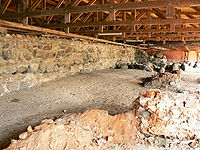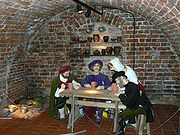
Klaipeda Castle
Encyclopedia

Archaeology
Archaeology, or archeology , is the study of human society, primarily through the recovery and analysis of the material culture and environmental data that they have left behind, which includes artifacts, architecture, biofacts and cultural landscapes...
site and museum housed in a castle
Ordensburg
An Ordensburg was a fortress built by crusading German military orders during the Middle Ages. "Ordensburg" was also used during Nazi Germany to refer to training schools for Nazi leaders.- Medieval Ordensburgen :...
built by the Teutonic Knights
Teutonic Knights
The Order of Brothers of the German House of Saint Mary in Jerusalem , commonly the Teutonic Order , is a German medieval military order, in modern times a purely religious Catholic order...
in Klaipėda
Klaipeda
Klaipėda is a city in Lithuania situated at the mouth of the Nemunas River where it flows into the Baltic Sea. It is the third largest city in Lithuania and the capital of Klaipėda County....
, Lithuania
Lithuania
Lithuania , officially the Republic of Lithuania is a country in Northern Europe, the biggest of the three Baltic states. It is situated along the southeastern shore of the Baltic Sea, whereby to the west lie Sweden and Denmark...
, near the Baltic Sea
Baltic Sea
The Baltic Sea is a brackish mediterranean sea located in Northern Europe, from 53°N to 66°N latitude and from 20°E to 26°E longitude. It is bounded by the Scandinavian Peninsula, the mainland of Europe, and the Danish islands. It drains into the Kattegat by way of the Øresund, the Great Belt and...
. The Teutons called the castle Memelburg or Memel, and Klaipėda was generally known as Memel until 1923, when Lithuanian military forces took over the city
Klaipeda Revolt
The Klaipėda Revolt took place in January 1923 in the Klaipėda Region . The region, located north of the Neman River, was detached from the East Prussia of the German Empire by the Treaty of Versailles and became a mandate of the League of Nations. It was placed under provisional French...
. The castle was first mentioned in written sources in 1252, and underwent numerous destructions and reconstructions in the centuries that followed. During the 19th century, having lost its strategic importance, the castle was demolished. Archeological work was performed at the site during the 20th century, and in 2002 a museum was established underneath one of its bastion
Bastion
A bastion, or a bulwark, is a structure projecting outward from the main enclosure of a fortification, situated in both corners of a straight wall , facilitating active defence against assaulting troops...
s.
History
The Christian Teutonic Order had been waging an ongoing war against the PrussiansOld Prussians
The Old Prussians or Baltic Prussians were an ethnic group, autochthonous Baltic tribes that inhabited Prussia, the lands of the southeastern Baltic Sea in the area around the Vistula and Curonian Lagoons...
during the 13th century; in order to entrench their gains, the Teutons built a number of castles in the area. One such castle was planned for a location between the Nemunas and Dangė rivers. A written account of this plan is dated to 1252, when a Grand Master of the Teutons, represented by Eberhard von Seyne, made an agreement with the Curonian
Curonians
The Curonians or Kurs were a Baltic tribe living on the shores of the Baltic sea in what are now the western parts of Latvia and Lithuania from the 5th to the 16th centuries, when they merged with other Baltic tribes. They gave their name to the region of Courland , and they spoke the Old...
bishop to build this fortification. In the same year the Christians constructed the castle and named it Memelburg. The new castle was wooden, protected by a tower, and was in a marsh
Marsh
In geography, a marsh, or morass, is a type of wetland that is subject to frequent or continuous flood. Typically the water is shallow and features grasses, rushes, reeds, typhas, sedges, other herbaceous plants, and moss....
y area. It is likely that this first castle was located on the left bank of the Danė river. It soon became a prime outpost in the war between the Christian Orders and the pagan
Lithuanian mythology
Lithuanian mythology is an example of Baltic mythology, developed by Lithuanians throughout the centuries.-History of scholarship:Surviving information about Baltic paganism in general is very sketchy and incomplete. As with most ancient Indo-European cultures Lithuanian mythology is an example of...
Lithuanians
Lithuanians
Lithuanians are the Baltic ethnic group native to Lithuania, where they number around 2,765,600 people. Another million or more make up the Lithuanian diaspora, largely found in countries such as the United States, Brazil, Canada, Colombia, Russia, United Kingdom and Ireland. Their native language...
allied with the Samogitians
Samogitians
Samogitians are a part of the Lithuanian ethnicity inhabiting the region of Samogitia in Lithuania. Many speak the Samogitian dialect of the Lithuanian language.-History:...
.
Probably because the low-lying area in which the first castle was built presented problems, a new stone castle was erected on the right bank of the Danė river in 1253. The new castle contained an enclosure; currently it is unknown whether it had any defensive tower. In 1379 the castle was destroyed in an attack by the Samogitians and Lithuanians. This destruction was followed by reconstruction; in 1393 a major defensive tower was erected, which was, however, destroyed by the Lithuanians in the same year. Continued expansions and renovations of the castle were systematically pursued until the 15th century. In 1408 and 1409 Grand Master Ulrich von Jungingen
Ulrich von Jungingen
Ulrich von Jungingen was the 26th Grand Master of the Teutonic Knights, serving from 1407 to 1410. His policy of confrontation with the Grand Duchy of Lithuania and the Kingdom of Poland sparked the Polish–Lithuanian–Teutonic War and led to disaster for the Order in the Battle of Grunwald.- Life...
arrived with additional military engineer
Military engineer
In military science, engineering refers to the practice of designing, building, maintaining and dismantling military works, including offensive, defensive and logistical structures, to shape the physical operating environment in war...
s, and the castle's upgrade was completed soon afterwards in 1409. After the Teutonic Order lost the key Battle of Grunwald
Battle of Grunwald
The Battle of Grunwald or 1st Battle of Tannenberg was fought on 15 July 1410, during the Polish–Lithuanian–Teutonic War. The alliance of the Kingdom of Poland and the Grand Duchy of Lithuania, led respectively by King Jogaila and Grand Duke Vytautas , decisively defeated the Teutonic Knights, led...
in 1410, the castle's military importance was sustained, as Lithuanian rulers regarded these territories as part of their patrimony. In the mid-15th century the castle was again upgraded to withstand assaults using firearm
Firearm
A firearm is a weapon that launches one, or many, projectile at high velocity through confined burning of a propellant. This subsonic burning process is technically known as deflagration, as opposed to supersonic combustion known as a detonation. In older firearms, the propellant was typically...
s.
As the technologies used in warfare continued to evolve, the castle was rebuilt several times. During the 16th century it was upgraded into a bastion, becoming one of the first such fortifications in the region. Between 1529 and 1559 the castle underwent an upgrade by French engineers. After its reconstruction the castle had five towers associated with the main building. The main tower probably had six floors and was about 15 meters in diameter. In 1629 the castle was devastated by Swedish
Swedish Empire
The Swedish Empire refers to the Kingdom of Sweden between 1561 and 1721 . During this time, Sweden was one of the great European powers. In Swedish, the period is called Stormaktstiden, literally meaning "the Great Power Era"...
attacks; it later suffered major fire damage. In 1757 the castle sustained severe damage during a war with Russia
Russian Empire
The Russian Empire was a state that existed from 1721 until the Russian Revolution of 1917. It was the successor to the Tsardom of Russia and the predecessor of the Soviet Union...
. The last known reconstruction of the castle was done in 1763.
During the late 18th century the castle lost its military importance and fell into disrepair. It was partially dismantled and its parts and materials were sold by local authorities. Between 1872 and 1874 the last remaining buildings were demolished.
Castle today

Adolfas Tautavicius
Adolfas Tautavičius was a Lithuanian archaeologist and Habilitated Doctor.In 1950 Adolfas Tautavičius graduated from Vilnius University and after four years in 1954 defended his thesis, Rytų Lietuva I m.e. tūkstantmetyje ...
. At that time a major cultural layer of the former Teuton castle was discovered. Excavations at the site have been ongoing since 1975; the work has been delayed by the urbanization of the area, which is near the Port of Klaipėda
Port of Klaipeda
The Port of Klaipėda is a seaport located in Klaipėda, Lithuania. It is one of the few ice-free ports in northernmost Europe, and the largest in Lithuania...
. Plans have been made to remove surrounding structures; this removal is scheduled for completion in 2009.
On August 1, 2002, in celebration of the City of Klaipėda's 750th anniversary, a museum was opened at the castle. The museum is located in the Prince Fredric chamber under the bastion, where artillery was stored in the 17th century. Visitors may familiarize themselves with the excavated findings, view the authentic remaining sections of the castle, and follow its historical development. The City of Klaipėda, in partnership with the European Network of National Heritage Organisations, envisions a re-integration of the castle and its surroundings with the Old Town and the Curonian Lagoon. The castle's site has since become one of Klaipėda's most popular tourist attractions. The annual Klaipėda Castle Jazz Festival
Klaipėda Castle Jazz Festival
The Klaipėda Castle Jazz Festival has been held annually during June or July in Klaipėda, Lithuania since 1994. It is staged near the ruined Klaipėda Castle....
is held on the grounds.

